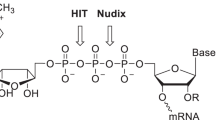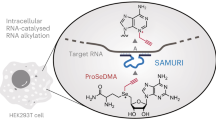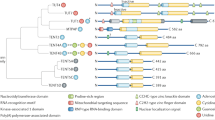Abstract
This protocol describes the detailed experimental procedure for the synthesis of an azide-modified uridine triphosphate analog and its effective incorporation into an oligoribonucleotide by in vitro transcription reactions. Furthermore, procedures for labeling azide-modified oligoribonucleotides post-transcriptionally with biophysical probes by copper(I)-catalyzed alkyne-azide cycloaddition (CuAAC) and Staudinger reactions are also provided. This post-transcriptional chemical modification protocol is simple and modular, and it affords labeled oligonucleotides in reasonable amounts for biophysical assays. The procedure for enzymatic incorporation of the monophosphate of azide-modified UTP into an oligoribonucleotide transcript takes ∼2 d, and subsequent post-transcriptional chemical functionalization of the transcript takes about 2 d.
This is a preview of subscription content, access via your institution
Access options
Subscribe to this journal
Receive 12 print issues and online access
$259.00 per year
only $21.58 per issue
Buy this article
- Purchase on Springer Link
- Instant access to full article PDF
Prices may be subject to local taxes which are calculated during checkout







Similar content being viewed by others
References
Khakshoor, O. & Kool, E.T. Chemistry of nucleic acids: impacts in multiple fields. Chem. Commun. 47, 7018–7024 (2011).
Wachowius, F. & Höbartner, C. Chemical RNA modifications for studies of RNA structure and dynamics. ChemBioChem. 11, 469–480 (2010).
Bell, N.M. & Micklefield, J. Chemical modification of oligonucleotides for therapeutic, bioanalytical and other applications. ChemBioChem. 10, 2691–2703 (2009).
Asseline, U. Development and applications of fluorescent oligonucleotides. Curr. Org. Chem. 10, 491–518 (2006).
Condon, A. Designed DNA molecules: principles and applications of molecular nanotechnology. Nat. Rev. Genet. 7, 565–575 (2006).
Seeman, N.C. An overview of structural DNA nanotechnology. Mol. Biotechnol. 37, 246–257 (2007).
Krishnan, Y. & Simmel, F.C. Nucleic acid based molecular devices. Angew. Chem. Int. Ed. 50, 3124–3156 (2011).
Keren, K. et al. Sequence-specific molecular lithography on single DNA molecules. Science 297, 72–75 (2002).
Kinsella, J.M. & Ivanisevic, A. DNA-templated magnetic nanowires with different compositions: fabrication and analysis. Langmuir 23, 3886–3890 (2007).
Heckel, A. & Famulok, M. Building objects from nucleic acids for a nanometer world. Biochimie 90, 1096–1107 (2008).
Blackburn, G.M., Gait, M.J., Loakes, D. & Williams, D.M. Nucleic Acids in Chemistry and Biology 3rd edn. Royal Society of Chemistry, 143–166 (2006).
Greco, N.J. & Tor, Y. Synthesis and site-specific incorporation of a simple fluorescent pyrimidine. Nat. Protoc. 2, 305–316 (2007).
Weisbrod, S.H. & Marx, A. Novel strategies for the site-specific covalent labelling of nucleic acids. Chem. Commun. 5675–5685 (2008).
Jäger, S. et al. A versatile toolbox for variable DNA functionalization at high density. J. Am. Chem. Soc. 127, 15071–15082 (2005).
Srivatsan, S.G. & Tor, Y. Synthesis and enzymatic incorporation of a fluorescent pyrimidine ribonucleotide. Nat. Protoc. 2, 1547–1555 (2007).
Pawar, M.G. & Srivatsan, S.G. Synthesis, photophysical characterization, and enzymatic incorporation of a microenvironment-sensitive fluorescent uridine analog. Org. Lett. 13, 1114–1117 (2011).
Kimoto, M. et al. Fluorescent probing for RNA molecules by an unnatural base-pair system. Nucleic Acids Res. 35, 5360–5369 (2007).
Stengel, G., Urban, M., Purse, B.W. & Kuchta, R.D. Incorporation of the fluorescent ribonucleotide analogue tCTP by T7 RNA polymerase. Anal. Chem. 82, 1082–1089 (2010).
Lang, K. & Micura, R. The preparation of site-specifically modified riboswitch domains as an example for enzymatic ligation of chemically synthesized RNA fragments. Nat. Protoc. 3, 1457–1466 (2008).
Hikida, Y., Kimoto, M., Yokoyama, S. & Hirao, I. Site-specific fluorescent probing of RNA molecules by unnatural base-pair transcription for local structural conformation analysis. Nat. Protoc. 5, 1312–1323 (2010).
Srivatsan, S.G. & Tor, Y. Enzymatic incorporation of emissive pyrimidine ribonucleotides. Chem. Asian J. 4, 419–427 (2009).
Tanpure, A.A. & Srivatsan, S.G. A microenvironment-sensitive fluorescent pyrimidine ribonucleoside analogue: synthesis, enzymatic incorporation, and fluorescence detection of a DNA abasic site. Chem. Eur. J. 17, 12820–12827 (2011).
Gramlich, P.M.E., Wirges, C.T., Manetto, A. & Carell, T. Postsynthetic DNA modification through the copper-catalyzed azide–alkyne cycloaddition reaction. Angew. Chem Int. Ed. 47, 8350–8358 (2008).
Best, M.D. Click chemistry and bioorthogonal reactions: unprecedented selectivity in the labeling of biological molecules. Biochemistry 48, 6571–6584 (2009).
Lallana, E., Riguera, R. & Fernandez-Megia, E. Reliable and efficient procedures for the conjugation of biomolecules through Huisgen azide–alkyne cycloadditions. Angew. Chem. Int. Ed. 50, 8794–8804 (2011).
Omumi, A., Beach, D.G., Baker, M., Gabryelski, W. & Manderville, R.A. Postsynthetic guanine arylation of DNA by Suzuki-Miyaura cross-coupling. J. Am. Chem. Soc. 133, 42–50 (2011).
Jin, S., Miduturu, C.V., McKinney, D.C. & Silverman, S.K. Synthesis of amine- and thiol-modified nucleoside phosphoramidites for site-specific introduction of biophysical probes into RNA. J. Org. Chem. 70, 4284–4299 (2005).
Weisbrod, S.H. & Marx, A. A nucleoside triphosphate for site-specific labelling of DNA by the Staudinger ligation. Chem. Commun. 1828–1830 (2007).
Gramlich, P.M.E., Warncke, S., Gierlich, J. & Carell, T. Click–click–click: single to triple modification of DNA. Angew. Chem. Int. Ed. 47, 3442–3444 (2008).
Sirivolu, V.R., Chittepu, P. & Seela, F. DNA with branched internal side chains: synthesis of 5-tripropargylamine-dU and conjugation by an azide-alkyne double click reaction. ChemBioChem. 9, 2305–2316 (2008).
Xu, Y., Suzuki, Y. & Komiyama, M. Click chemistry for the identification of G-quadruplex structures: discovery of a DNA–RNA G-quadruplex. Angew. Chem. Int. Ed. 48, 3281–3284 (2009).
Franzini, R.M. & Kool, E.T Efficient nucleic acid detection by templated reductive quencher release. J. Am. Chem. Soc. 131, 16021–16023 (2009).
Beyer, C. & Wagenknecht, H.-A. In situ azide formation and 'click' reaction of nile red with DNA as an alternative postsynthetic route. Chem. Commun. 46, 2230–2231 (2010).
Sharma, A.K. & Heemstra, J.M. Small-molecule-dependent split aptamer ligation. J. Am. Chem. Soc. 133, 12426–12429 (2011).
Pianowski, Z., Gorska, K., Oswald, L., Merten, C.A. & Winssinger, N. Imaging of mRNA in live cells using nucleic acid-templated reduction of azidorhodamine probes. J. Am. Chem. Soc. 131, 6492–6497 (2009).
Furukawa, K. et al. Reduction-triggered fluorescent amplification probe for the detection of endogenous RNAs in living human cells. Bioconjugate Chem. 20, 1026–1036 (2009).
El-Sagheer, A.H. & Brown, T. New strategy for the synthesis of chemically modified RNA constructs exemplified by hairpin and hammerhead ribozymes. Proc. Natl. Acad. Sci. USA 107, 15329–15334 (2010).
Jayaprakash, K.N. et al. Non-nucleoside building blocks for copper-assisted and copper-free click chemistry for the efficient synthesis of RNA conjugates. Org. Lett. 12, 5410–5413 (2010).
Van Delft, P. et al. Synthesis of oligoribonucleic acid conjugates using a cyclooctyne phosphoramidite. Org. Lett. 12, 5486–5489 (2010).
Peacock, H., Maydanovych, O. & Beal, P.A. N2-Modified 2-aminopurine ribonucleosides as minor-groove-modulating adenosine replacements in duplex RNA. Org. Lett. 12, 1044–1047 (2010).
Onizuka, K., Shibata, A., Taniguchi, Y. & Sasaki, S. Pin-point chemical modification of RNA with diverse molecules through the functionality transfer reaction and the copper-catalyzed azide–alkyne cycloaddition reaction. Chem. Commun. 47, 5004–5006 (2011).
Paredes, E. & Das, S.R Click chemistry for rapid labeling and ligation of RNA. ChemBioChem. 12, 125–131 (2011).
Wada, T. et al. Synthesis and properties of 2-azidodeoxyadenosine and its incorporation into oligodeoxynucleotides. Tet. Lett. 42, 9215–9219 (2001).
Kiviniemi, A., Virta, P. & Lönnberg, H. Utilization of intrachain 4′-C-azidomethylthymidine for preparation of oligodeoxyribonucleotide conjugates by click chemistry in solution and on a solid support. Bioconjugate Chem. 19, 1726–1734 (2008).
Pourceau, G., Meyer, A., Vasseur, J.-J. & Morvan, F. Azide solid support for 3′-conjugation of oligonucleotides and their circularization by click chemistry. J. Org. Chem. 74, 6837–6842 (2009).
Aigner, M. et al. Chemical synthesis of site-specifically 2′-azido-modified RNA and potential applications for bioconjugation and RNA interference. ChemBioChem. 12, 47–51 (2011).
Rao, H., Sawant, A.A., Tanpure, A.A. & Srivatsan, S.G. Post-transcriptional chemical functionalization of azide-modified oligoribonucleotides by bioorthogonal click and Staudinger reactions. Chem. Commun. 48, 498–500 (2012).
Moffatt, J.G. A general synthesis of nucleoside-5′ triphosphates. Can. J. Chem. 42, 599–604 (1964).
Aoki, S., Matsuo, N., Hanaya, K., Yamada, Y. & Kageyama, Y. Design and synthesis of a photocleavable biotin-linker for the photoisolation of ligand–receptor complexes based on the photolysis of 8-quinolinyl sulfonates in aqueous solution. Bioorg. Med. Chem. 17, 3405–3413 (2009).
Coutouli-Argyropoulou, E., Tsitabani, M., Petrantonakis, G., Terzis, A. & Raptopoulou, C. Labeling of organic biomolecules with ethynylferrocene. Org. Biomol. Chem. 1, 1382–1388 (2003).
Furniss, B.S., Hannaford, A.J., Smith, P.W.G. & Tatchell,, A.R. Vogel's Textbook of Practical Organic Chemistry 5th ed. (Pearson Education, 2008).
Milligan, J.F. & Uhlenbeck, O.C. Synthesis of small RNAs using T7 RNA polymerase. Methods Enzymol. 180, 51–62 (1989).
Acknowledgements
This research is supported by the Department of Science and Technology, India (SR/S1/OC-51/2009). A.A.T. and A.A.S. are thankful to the Council of Scientific and Industrial Research, India, for a graduate research fellowship.
Author information
Authors and Affiliations
Contributions
S.G.S. designed and directed the research. H.R. and A.A.T. synthesized the triphosphate analog and optimized the conditions for Staudinger reduction of azide-modified RNA. A.A.S. performed post-transcriptional click reactions on RNA. All authors discussed the results and wrote the manuscript.
Corresponding author
Ethics declarations
Competing interests
The authors declare no competing financial interests.
Rights and permissions
About this article
Cite this article
Rao, H., Tanpure, A., Sawant, A. et al. Enzymatic incorporation of an azide-modified UTP analog into oligoribonucleotides for post-transcriptional chemical functionalization. Nat Protoc 7, 1097–1112 (2012). https://doi.org/10.1038/nprot.2012.046
Published:
Issue Date:
DOI: https://doi.org/10.1038/nprot.2012.046
Comments
By submitting a comment you agree to abide by our Terms and Community Guidelines. If you find something abusive or that does not comply with our terms or guidelines please flag it as inappropriate.



